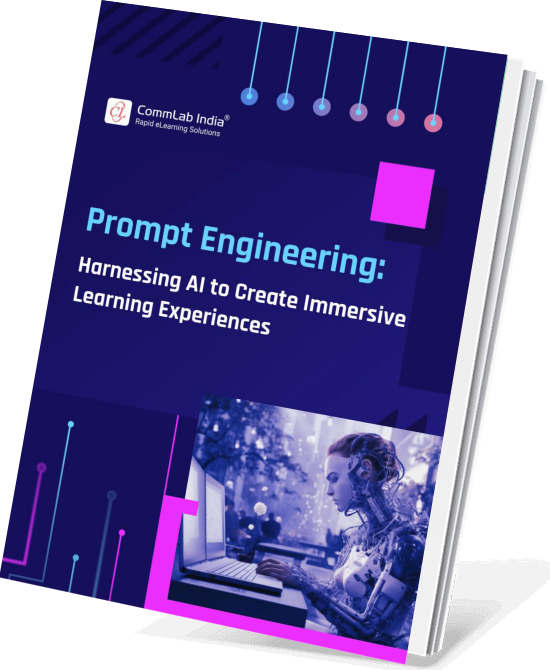Instructional Design in the Times of AI
Instructional design is the backbone of eLearning design and development. Here’s a comprehensive guide to AI-powered instructional design.

Part 1 — Instructional Design Basics
What is Instructional Design in eLearning?
Welcome to the fascinating world of Instructional Design!
Instructional design (ID) refers to the systematic process of creating effective online learning experiences for employees. It involves designing and developing courses, modules, or training programs that align with business goals, enhance employee skills, and improve performance, thereby helping businesses thrive.
Watch this video to know about the six must-have skills to master instructional design.
Chapters
Why is Instructional Design Important?
Instructional design is crucial for the success of an eLearning course. The goal is to optimize learning outcomes and boost the performance and productivity of employees. Here are a few benefits of sound instructional design:
- Makes learning learner-centered
- Helps in crafting efficient learning paths
- Focuses on meaningful performances
- Makes the learning purposeful and measurable
- Factors for diverse learning styles, ensuring inclusivity

Prompt Engineering — Harnessing AI to Create Immersive Learning Experiences
Learn the Art of Crafting Effective Prompts and Get Desired Outcomes
- What is Prompt Engineering?
- Why is Prompt Engineering Important?
- How to Craft Effective Prompts?
- And More!
What is the Role of Instructional Designers?
Instructional designers are the architects of effective learning experiences. They play a pivotal role in shaping successful corporate training programs. Their role extends beyond content creation; they shape the entire learning journey. They collaborate with Subject Matter Experts (SMEs) to analyze training needs, identify gaps, define learning objectives, create engaging learning solutions, and appropriate delivery methods and develop ways to capture impact. Here’s what they do:
1. Setting Clear Learning Goals and Getting Learners to Focus on Them
Instructional designers define specific learning objectives for each module or course. These goals guide content creation. They ensure alignment between learning objectives, assessments, interactivities, desired learning outcomes, and business goals.
2. Improving Learner Performance Through Apt Training
Instructional designers design training that bridges knowledge gaps and builds skills. They consider different learning styles, adapt content, and create assessments to measure progress.
3. Designing Learning Content Creatively
Instructional designers create engaging content that aligns with learning objectives. They use multimedia elements such as videos, infographics, interactive modules, and more to enhance understanding. They transform complex information into digestible formats.
4. Engaging Learners with Clear, Simple, and Meaningful Content
Instructional designers focus on clarity. They break down complex concepts, use plain language, and avoid jargon. They use visuals, storytelling, and relatable examples to make content meaningful and memorable.
5. Enhancing Learning Outcomes and Boosting Training ROI
Effective instructional design leads to improved learning outcomes. Learners retain knowledge, apply skills, and transfer them to real-world scenarios. Ultimately, this positively impacts an organization’s return on investment (ROI) by enhancing employee performance and productivity.
Learn the A to Z of Instructional Design.
Part 2 — The Current State of Instructional Design
What is the Market Saying about Instructional Design in 2024 and Beyond?
eLearning is one of the most popular training formats in today’s dynamic corporate L&D landscape. The market for eLearning is projected to reach USD 282 billion by 2030. This makes instructional design one of the top jobs in demand. According to the Bureau of Labor Statistics, the demand for instructional designers is expected to increase by 11%, by 2026.
Also, to match rapidly changing market trends and dynamic business scenarios, L&D teams are looking forward to crafting training programs that futureproof the workforce and drive innovation and creativity. Consequently, strong instructional design is gaining immense prominence and is becoming the pillar to crafting learning experiences that align with the evolving learning needs and preferences of modern learners.
How is AI Making Instructional Design Faster and More Creative?
The role of AI in our everyday lives is noteworthy. Whether it’s Alexa playing our favorite music or AI Chatbots solving queries 24*7, AI is everywhere.
When it comes to the corporate learning and development space, AI is paving the path for modern methods of learning. Let’s delve into how AI is transforming instructional design and making it more efficient, creative, and learner-centric. Here’s a breakdown of the key areas where AI plays a crucial role:
1. Content Creation
Content that engages is at the heart of an eLearning course. Naturally, IDs spend a considerable amount of time creating content that garners learner attention. Leveraging AI-powered NLP tools like ChatGPT assists in generating high-quality creative content that engages learners, facilitates active learner participation, and boosts learning outcomes.
In the times of AI and Machine Learning (ML), content curation is also a data-driven process. IDs can leverage data-driven insights to focus on individual learner needs and curate apt content to chart effective training programs for learners.
Usher a Revolutionary Approach to Instructional Design with ChatGPT! — A Comprehensive eBook
2. Designing Interactivities and Assessments
Interactivities and engaging assessments are crucial to designing an interactive eLearning course. Thanks to AI tools, we can effortlessly enhance interactivity by creating gamified elements, simulations, and assessments.
Instructional designers can use these AI tools to design game-like experiences that motivate learners and reinforce knowledge. AI-driven simulations allow learners to practice real-world scenarios, improving their skills. AR/VR-based simulation exercises transport learners to a virtual world where they experience real-world situations and learn in a risk-free environment. When it comes to eLearning assessments, AI tools can develop them at any level of complexity, depending on the specified learning objectives. AI platforms can also adapt assessments based on individual learner performances and provide personalized feedback.
Say Yes to Impactful Assessments, Leverage Generative AI for MCQs [eBook]
3. Crafting Personalized Learning Pathways
AI-powered learning analytics provide insights into learner behavior, engagement, and performance. AI identifies knowledge gaps by analyzing learner data (past performance, preferences, and pace). It also recommends relevant content to bridge these gaps and aids in modifying courses based on individual learner behavior, progress, and performance. Instructional designers can use these insights to craft personalized learning paths for learners and offer engaging learning experiences.
4. AI-Powered Adaptive Learning Platforms
Unlike traditional Learning Management Systems (LMSs), modern Learning Experience Platforms (LXPs) focus on learner experience and aim to provide personalized learning journeys. These platforms leverage AI and ML algorithms to customize learning content based on each learner’s progress and preferences. Ai-powered LXPs anticipate learner needs and recommend relevant resources. They also assess learning effectiveness and adjust content accordingly. Instructional designers can use these platforms to gather relevant insights and tailor customized learning paths to meet diverse learning needs.
AI is powerful! Explore how Generative AI is reshaping employee training.
What Modern Skillsets Do Today’s IDs Need?
In the present time when the world is awake to AI’s impact in every sphere, organizations must empower employees to grow and thrive. Learning agility is the key to the modern-day dynamic business environment and upskilling and reskilling are at the heart of business growth and success.
As we navigate an AI-driven world, the role of instructional designers is crucial and is also becoming mission- critical, requiring diverse skill sets to address the challenges of a rapidly evolving corporate L&D landscape.
Here’s what today’s IDs need to drive the course of corporate L&D:
1. Expertise in Learning Science and Data Analysis
Market trends and business dynamics are evolving like never before, leading to more personalized learning based on changing requirements. This calls for gaining expertise in learning science, cognitive psychology, and data analytical skills. IDs who have prowess in these traits will be able to design courses that integrate learning science with innovative instructional strategies to craft customized learning journeys to address the needs of modern learners.
2. Proficiency in Learning Tools and Technologies
The corporate L&D space is evolving, and digital learning is at the forefront. With rapid technological advancements, IDs must upskill themselves to get mastery over the latest tools and technologies. Proficiency in AItools, Virtual Reality (VR) platforms, and LXPs will help instructional designers create immersive and interactive learning experiences to create sticky learning.
3. Prowess in Critical Thinking and Problem-Solving
Effective learning approaches focus on performance-based learning, clearly aligned to business goals. Instructional designers must hone their critical thinking and problem-solving skills to identify the problem that can be solved through training and then present content in such a manner that encourages learners to think and apply their learning in situations that mimic real-life work scenarios.
4. Polished Human Skills
According to the LinkedIn Workplace Learning Report 2024, 91% of L&D pros agree that human skills or soft skills are essential in present times. Collaboration and teamwork are the most needed skills for instructional designers as they deal with a team of versatile professionals including fellow IDs, clients, Subject Matter Experts (SMEs), eLearning developers, and other key stakeholders. Moreover, in today’s time when L&D teams are pressed against time and training needs are higher than ever, collaboration and teamwork rev up the eLearning design and development process. Good communication skills, presentation skills, and interpersonal skills will help IDs have an edge in the AI-driven competitive world.
Image Source: LinkedIn Workplace Learning Report 2024
Part 3 — The Evergreen Essentials of Instructional Design
What are the Essentials of Instructional Design?
Instructional Design has always been at the core of any learning. Sound instructional design lays the foundation of a learner-centric eLearning course. Let’s see what forms the basis of strong instructional design.

Prompt Engineering — Harnessing AI to Create Immersive Learning Experiences
Learn the Art of Crafting Effective Prompts and Get Desired Outcomes
- What is Prompt Engineering?
- Why is Prompt Engineering Important?
- How to Craft Effective Prompts?
- And More!
The Triumphant Trio — The Learning Cycle, Adult Learning Principles, and Learning Styles
For learning to be effective, a fair understanding of the learning cycle is crucial for IDs. In-depth knowledge of adult learning principles and various learning styles is also important to design eLearning courses that help achieve desired learning outcomes.
Let’s take a closer look at each component.
Learning Cycle

Image: Phases of the Learning Cycle (Adapted from David Kolb’s Learning Cycle)
The above picture demonstrates the various phases of the learning cycle and determines how we learn. For the learning to be effective, IDs must follow this sequence while designing eLearning courses.
Adult Learning Principles
Adult learners are unique and so are their learning needs. While designing courses for corporate employees, it’s essential to abide by the principles of adult learning.
Adult Learning Principles — A Snapshot
Principle 1: Adults need to know why they should learn something. Make sure you answer the“What’s in it for me” (WIIFM)
Principle 2: Adults are self-directed learners. Allow them choice - this could take many forms. For example, give unrestricted navigation through eLearning courses and involve them in the learning process. When it comes to learning journeys, allow the learners to test out of topics, so that they have the freedom to skip the ones they are skilled in.
Principle 3: The adult brain isn’t a clean slate. They have prior knowledge and past experiences, so develop strategies to take them from the known to the unknown.
Principle 4: Adults feel the need to learn something if they feel it would help ease their task. Let them know how the course will help them enhance efficiency.
Principle 5: Adults are ready to learn something that can solve their day-to-day work challenges. Make sure to design courses from a problem-centered perspective.
Principle 6: Adults get motivated by intrinsic as well as extrinsic motivators. Apart from extrinsic rewards, give learners a sense of achievement by ensuring your courses have features like scores, levels, and badges.
Learning Styles
Adult learners have different learning styles. What works for you might not work for me. A clear understanding of various learning styles is crucial to designing eLearning courses for meaningful learning.
The three different learning styles or preferences are auditory (prefer learning through audio content), visual (learn better via visual content), or kinesthetic (prefer to learn by doing).
Here’s how you can craft learning experiences suitable for each learning style:

Image: Learning Styles
What is the Instructional Design Process for eLearning?
The ID process includes the following steps:
- Need Analysis
- Framing Learning Objectives
- Preparing Storyboards
- Prototyping
- Designing the eLearning Courses
Need Analysis
Conducting a need analysis helps identify and assess the gap between the current state and the desired state of knowledge or skills. It gives a fair idea of what learners already know, what they need to know, and how to bridge the gap effectively using suitable learning strategies.

Read this blog to explore how to conduct an effective need analysis for eLearning.
Framing Learning Objectives
Learning Objectives (LOs) lay the foundation for a successful eLearning course. They are simple, clear, and precise statements that describe what learners will be able to accomplish after completing the course.
Well-defined learning objectives steer the direction of eLearning courses as they help:
- Define the scope of the content
- Decide the instructional strategy
- Set the parameters for evaluation
- Ensure optimal utilization of resources
- Save time and cost
Watch this video to learn the key steps in setting learning objectives
Read the blog for quick tips to frame effective learning objectives.
Preparing Storyboards
Behind every awesome eLearning course is a well-designed storyboard. Storyboarding is a graphic representation of the structure, the content, graphics and interactivities in an eLearning course. They can be developed in PowerPoint, which is recommended as it mirrors the look of the actual course far better than a storyboard in Microsoft Word.

Keen to master the art of perfect storyboarding? Read this blog for amazing tips.
Prototyping
A prototype is a working sample of an eLearning course. It is developed to test the visual elements, interactivities, and LMS compatibility.
Here’s an infographic that details the elements and benefits of an eLearning prototype.
Designing the eLearning Course
Once the prototype is approved, the instructional designer designs the entire course. And here comes the role of instructional design strategies and multimedia elements.
Let’s delve into the various instructional design strategies and multimedia elements to design learner-centric eLearning courses.
How Do Instructional Design Strategies Help in Designing Impactful eLearning?
An Instructional Design (ID) Strategy is a high-level plan of how a subject or a topic must be taught. You may have great content but how you deliver it to the learners to ensure meaningful learning is what matters the most.
Here are a few popular ID strategies for effective learning:
- Storytelling
- Scenario-Based Learning
- Guided Learning or Avatar-Based Learning
- Gamification
- Simulations
Storytelling
Storytelling involves using narratives to convey information, engage learners, and create memorable experiences. In corporate training, stories can illustrate real-world scenarios, organizational challenges, or success stories. Storytelling humanizes content, making it relatable and memorable. It helps employees connect with concepts, retain information, and apply it in their work. Incorporate relatable characters, plotlines, and conflict resolution into your training modules to breathe life into your training content.

Combine the Age-Old Art of Storytelling with the Power of AI to Weave Magical eLearning Experiences [eBook]
Scenario-Based Learning
Scenario-based learning presents learners with realistic situations they might encounter in their roles. Learners make decisions and experience consequences based on their choices. Scenarios promote critical thinking, problem-solving, and decision-making skills. They bridge theory and practice, preparing employees for real-world challenges. Develop scenarios that mirror workplace situations and include branching paths and reflection opportunities.

Gain Practical Insights and Expert Guidance to Design Scenarios That Help Your Learners Learn Ways to Navigate Real-Life Work Challenges [eBook]
Guided Learning or Avatar-Based Learning
Guided learning involves using avatars or virtual guides to lead learners through content. Avatars provide personalized assistance, answer questions, and offer guidance. They create an interactive and supportive learning environment. They enhance engagement and provide a human touch, especially in self-paced eLearning. Design avatars with relatable personalities. Use them for simulations, role-playing, or step-by-step instructions.
A Detailed Infographic to Guide You Through the Nitty-Gritty of Avatar-Based Learning
Gamification
Gamification enables you to apply game elements such as points, badges, and leaderboards to training modules. It transforms learning into an engaging and fun experience. Gamification motivates learners, encourages healthy competition, and rewards progress. It fosters a positive learning culture. Integrate interesting challenges and quizzes into training modules to involve learners and ensure meaningful learning.
Unleash the Potential of AI-enhanced Gamification for Immersive Learning Experiences [eBook] Game on!
Simulations
Simulations replicate real-world processes, systems, or tasks. Learners interact with a lifelike environment, practicing skills without real-world consequences. Simulations build practical skills, boost confidence, and reduce on-the-job errors. They are valuable for technical training, compliance, and complex procedures where exposure to real scenarios is challenging. You can create interactive simulations using software or virtual environments including guided practice, troubleshooting, and performance assessments to offer hands-on practice to learners.
Here's How eLearning Simulations Help Impart Experiential Sales Training [Case Study]
As an instructional designer, you have the freedom to mix and match the various instructional design strategies to design different modules of a curriculum. Make sure you choose the right strategy; consider your learners, their learning environment, the training objectives, and the content in hand.
Here’s an eBook to help you understand how to use the various instructional design strategies to design learner-centric courses, how to select the right ID strategy, and a few use cases for quick reference.
Instructional Design Strategies to Design Learner-Centric eLearning Courses [eBook]
The Role of Multimedia in Instructional Design — How Do They Spice Up eLearning Courses?
The use of multimedia in courses levels up your eLearning game. They are the treasured gems that help you implement various instructional design strategies into the eLearning courses. These elements augment employee engagement, boost retention, and facilitate the practical application of learning, thereby boosting employee performance and productivity.
Here are a few popular multimedia elements that can spice up your eLearning courses:
- Videos
- Graphics and Images
- Audio
- Animations
- Gaming Elements
- Interactive Quizzes
Authoring Tools — How do They Ally with Instructional Design?
Modern AI-powered authoring tools offer inbuilt templates, backgrounds, and a rich multimedia library that makes eLearning development a breeze. With multiple modern features and functionalities, these authoring tools are an instructional designer's best buddy. You are no longer expected to be proficient in programming languages and can develop eLearning courses of any kind in no time.

Image: Why Use Authoring Tools for eLearning Development?
Here’s an infographic that showcases the surprising benefits of eLearning authoring tools.
AI-powered authoring tools have made eLearning course development way easier. The best part is you can learn using these tools with little effort as they offer a minimal learning curve.
Here are a few popular eLearning authoring tools that are the compass for innovative, efficient, and data-driven corporate learning:
- Adobe Captivate
- Articulate Storyline
- iSpring Suite
- Lectora
- Elucidat
- dominKnow
Read this blog to take a look at the features and benefits of the top 7 authoring tools in 2024.
Each authoring tool comes with its own set of unique features and benefits, promising to deliver awesome eLearning courses that captivate learners. How to choose what works best for you?
Well, here’s a tool that’ll guide you to find the authoring tool that best suits your learners and aligns with your training and learning needs. Get access now!
Authoring Tool Finder: Find the Right Authoring Tool That Works Best For You
The Impact of Effective Instructional Design on Training ROI
Effective instructional design significantly impacts corporate training ROI. It ensures aligning learning with business goals, the use of apt ID strategies to enhance learner engagement and boost retention fostering behavioral changes. Strategic instructional design not only enhances learning outcomes but also positively impacts the bottom line by maximizing training effectiveness and employee performance. By working on continuous improvement strategies and charting adaptive learning pathways for learners, instructional designers can certainly keep up the training ROI graph.
Watch this video to explore seven actionable strategies for instructional designers to optimize corporate training ROI.
Part 4: The Road Ahead for Instructional Design Champions
How IDs Can Futureproof Themselves — The Roadmap to Growth
Businesses today are evolving at a lightning speed and to keep up with the pace of rapidly changing business and training needs, instructional designers must stay current. Upskilling is an ongoing journey. Instructional designers must embrace curiosity, seek mentorship, and adapt to industry shifts. By doing so, they can create impactful learning experiences and contribute effectively to organizational success.
Here are a few ways that can help IDs prepare themselves for the ongoing revolution in the corporate training landscape and face upcoming challenges confidently:
1. Continuous Upskilling and Reskilling
The field of instructional design evolves rapidly. To stay relevant, instructional designers must commit to lifelong learning.
What Can IDs Do?
- Enroll in online courses and certifications related to instructional design, eLearning, or adult learning theory. Platforms like Coursera, Udemy, and LinkedIn Learning offer relevant programs.
- Regularly consume bite-sized content on topics such as modern learning methodologies, learning analytics, user experience (UX) design, or multimedia development.
- Continuously evaluate your work, seek feedback, and adjust your approach. Learn from successes and failures.
2. Attending Conferences and Workshops
Conferences and workshops provide exposure to industry trends, best practices, and networking opportunities.
What Can IDs Do?
- Attend popular industry conferences such as ATD (Association for Talent Development). Participate in sessions, workshops, and panel discussions.
- Join local instructional design or eLearning groups. Engage with peers, share experiences, and learn from guest speakers.
3. Networking with Subject Matter Experts (SMEs)
SMEs provide domain-specific knowledge critical for effective instructional design.
What Can IDs Do?
- Work closely with SMEs during content development. Understand their expertise and perspectives.
- Conduct interviews or surveys to extract valuable insights. SMEs can clarify complex concepts and provide context.
- Regularly seek feedback from SMEs on your designs. Their input ensures accuracy and relevance.
- Join online communities and forums to learn from subject matter and domain experts.
4. Staying Abreast of New Tools and Technologies
Technology shapes instructional design. Familiarity with tools and platforms enhances your capabilities.
What Can IDs Do?
- Learn popular tools like Articulate Storyline, Adobe Captivate, or Lectora. Stay updated on new features.
- Understand LMS and LXP functionalities, integrations, and reporting capabilities.
- Explore emerging technologies such as virtual reality (VR), augmented reality (AR), and interactive video. Understand how they impact learning experiences.
- Study User Experience (UX) principles to create learner-friendly interfaces.
The Way Ahead — Paving the Path of Instructional Design, the AI Way
Instructional design is a dynamic field. As the corporate learning and development (L&D) world sets its course of continuous growth and evolution, instructional design too needs to match the pace to ensure meaningful learning. By aligning with recent advancements in the field of corporate L&D, new tools and technologies, and innovative learning methodologies, instructional designers can make meaningful contributions to crafting immersive learning experiences that help organizations stay ahead of the curve.
AI-powered instructional design is the new success mantra. Get your hands on the eBook “Prompt Engineering: Harnessing AI to Create Immersive Learning Experiences” to learn the art of crafting effective prompts and leveraging its power to ride the AI wave like a pro!






![eLearning Prototype: Elements and Benefits/What and Why [Infographic] eLearning Prototype: Elements and Benefits/What and Why [Infographic]](https://blog.commlabindia.com/hs-fs/hubfs/Imported_Blog_Media/elearning-prototype-elements-benefits-infographic.jpg?width=1875&height=7419&name=elearning-prototype-elements-benefits-infographic.jpg)





![6 Surprising Benefits of Rapid Authoring Tools [Infographic] 6 Surprising Benefits of Rapid Authoring Tools [Infographic]](https://blog.commlabindia.com/hs-fs/hubfs/Imported_Blog_Media/6-benefits-of-rapid-authoring-tools-infographic.jpg?width=2062&height=4165&name=6-benefits-of-rapid-authoring-tools-infographic.jpg)

![Instructional Design Strategies for eLearning [What, Why, & How]](https://blog.commlabindia.com/hubfs/blogs/instructional-design-strategy-importance-in-elearning.jpg)

